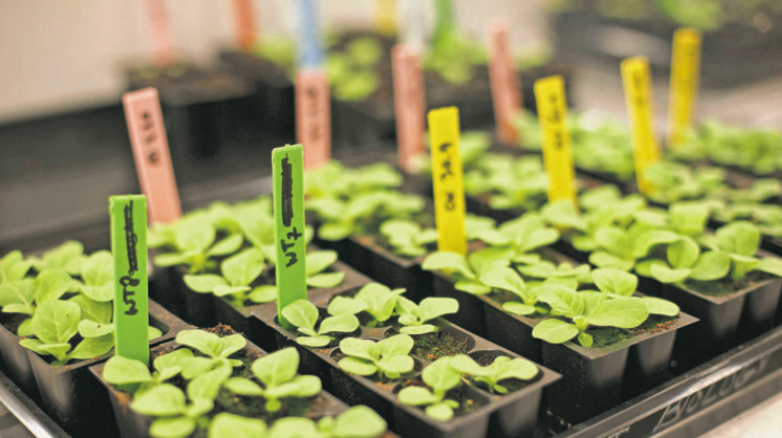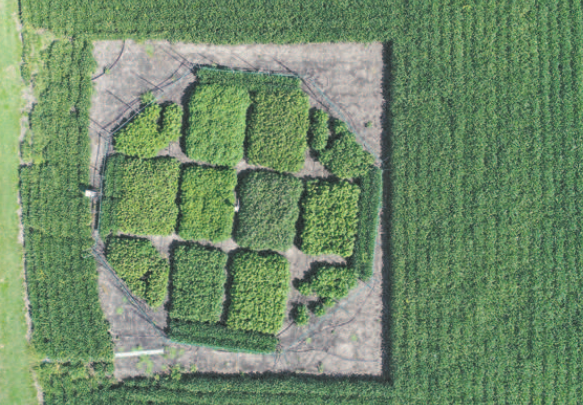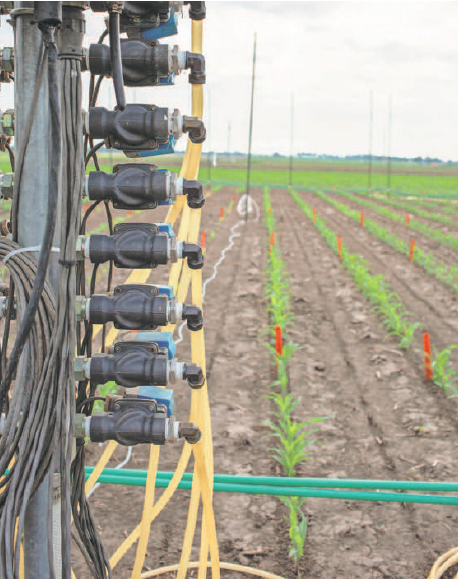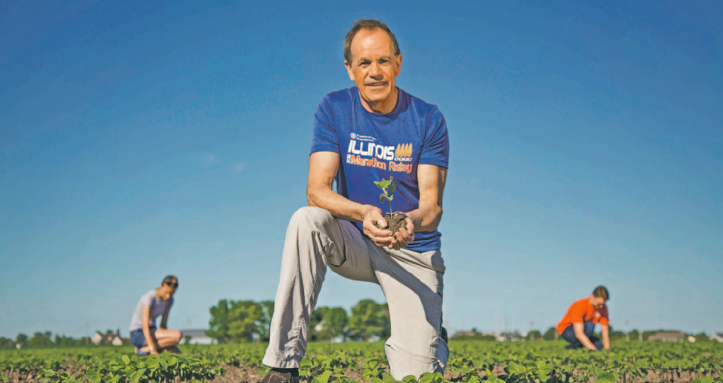Green Genes: Agronomists are engineering DNA to save some foods from extinction

Climate change feels like an unprecedented global challenge. But the truth is, humanity has been here before — approximately 11,000 years ago. That’s when the last Ice Age ended.
Enormous ice sheets had spent the preceding millennia engulfing continents like a glacial conflagration. Then, suddenly, Earth began to warm. Ice melted, altering the jet streams that shape global weather patterns. Precipitation patterns changed, transforming lush grasslands into dense forests and barren deserts. Their habitats vanquished and large herbivores perished along with their predators. Among the losses were saber-toothed tigers, woolly mammoths, dire wolves and ground sloths, each of which was consigned to the annals of extinction.
Although the circumstances are different, with most scientists agreeing that modern-day climate change is the result of human activity, global warming today looks a lot like it did then.
This time, however, humans have a lot more to lose. Like prehistoric fauna, they could see dramatic shifts in their food supply due to changing weather patterns. At risk are commodity crops like corn, wheat, soy and rice, as well as specialty crops like avocados, coffee, cocoa, peaches, berries and wine grapes, just to name a few.
“We have very major problems ahead with food supply,” said Stephen Long, endowed chair of crop sciences and plant biology at the University of Illinois. “We probably are going to lose some crops, and others are going to become far less productive.”
But don’t mourn your favorite snacks just yet. Scientists like Long already are cultivating solutions to rescue them. One of the most promising lies inside the foods themselves, many of which possess climate-resistant genes that could be exploited to make imperiled crops impervious.

CROPS IN CRISIS
Average temperatures in the contiguous United States have been rising since 1901, with an increased rate of warming over the last three decades, according to the U.S. Environmental Protection Agency (EPA). The effect on farming can be dramatic: An increase in temperature of just 1 degree Celsius causes a decrease in crop yields of approximately 3 percent to 8 percent, according to the National Academy of Sciences.
“That’s a lot in a world where the population is growing and you actually have to produce more food, not less,” says Hannes Dempewolf, senior scientist and head of global initiatives at the Crop Trust, an international organization with the mission of ensuring crop diversity for global food security.
Stressing the food system even further are floods and droughts, both of which are becoming more common in certain vulnerable regions — including parts of the United States. At any given time over the past 20 years, roughly 20 percent to 70 percent of the country has experienced abnormally dry conditions, according to the EPA.
Impacts abound. “For example, Montana has been experiencing decreased annual snowpack, which means less consistent water for irrigating commodity and staple crops such as sugar beets, barley and potatoes,” said Nicole Wagner, an assistant professor in the Department of Agricultural Sciences at Texas State University in San Marcos, Texas. “Another example is that a major commodity crop like corn … is threatened in the lower Midwest states due to more frequent heat waves.”
The coasts are not immune. In California, for example, eyes are on avocados. “Avocado habitat is likely getting warmer and dryer, and that will impact both disease profiles and fruit yield,” said Victor A. Albert, professor of biology at the University at Buffalo in Buffalo, N.Y. “Disease is probably the biggest problem avocado is facing: Climate change means new pests might move in that avocado varieties... aren’t well adapted to.”
On the East Coast, peanuts are in peril. “Peanuts tend to be grown in sandy soil, which is vulnerable to dry conditions,” said Thomas Sinclair, an adjunct professor in the Department of Crop and Soil Sciences at North Carolina State University in Raleigh.
While American agronomists are rightly concerned, stakes are greatest in developing nations. Consider rice crops in Asia, for example. “Most rice varieties grow well in standing water, but will die if they’re completely covered for more than three days,” said Pamela Ronald, a distinguished professor in the Department of Plant Pathology at the University of California, Davis. “That’s a big problem in India and Bangladesh, where 4 million tons of rice — enough to feed 30 million people — is lost every year to flooding. Because of climate change, that flooding is predicted to increase in both frequency and intensity.”
When crops are lost, hunger is just the first of many consequences, according to Long, who recalls the Arab Spring of 2011, a major impetus of which was a wheat shortage that caused an increase in global grain prices that pinched vulnerable people in Islamic countries like Tunisia, Libya and Egypt. “If wheat prices tripled, it wouldn’t have a big effect for most people in the United States,” Long said. “But in the poorest countries in the world, it could be a catastrophe that leads to civil unrest and mass migration.”
SOWING STRONGER GENES
At home and abroad, the road to crop security is paved in DNA. “There will never be one solution, but genetic strategies are an important tool in the toolbox,” suggested Ronald, who said genetic solutions are attractive because they don’t require farmers to change their practices; all they have to do is sow new seeds.
Scientists have been deploying genetic strategies for more than 100 years in the form of conventional plant breeding, wherein plants with desirable characteristics are isolated, then crosspollinated to produce new varieties that possess their progenitors’ best traits. Unfortunately, conventional breeding is slow, often taking decades to yield results. Modern breeders have therefore developed a shortcut known as marker-assisted breeding, in which the individual genes that are responsible for specific characteristics are identified and “marked” at the molecular level. These markers make it easy for breeders to determine when plant progeny have inherited the desired genes, thereby accelerating the breeding process.

Marker-assisted breeding has enormous potential in the context of climate change, according to Ronald, who in 1996 commenced a 10-year study of an ancient rice variety that could survive weeks underwater instead of days. When her laboratory eventually isolated the crop’s “submergence tolerance” gene, researchers used marker-assisted breeding to propagate new varieties of flood-resistant rice that more than 6 million farmers are now cultivating.
Scientists are dissecting other crops’ DNA in pursuit of similar results. Sinclair, for example, has identified a water-conservation gene in peanuts that has been bred into a new variety of drought-resistant legume that will arrive on peanut farms this year. Albert, meanwhile, recently sequenced the avocado genome.
“An avocado genome paves the way to mapping, understanding and utilizing knowledge of disease-resistance genes to breed more resistant avocados — perhaps also ones that are more drought-resistant, or even less temperature-sensitive — so that the fruits can be produced better in drier and even more northerly climates,” Albert said.
As was the case in Ronald’s rice project, coveted genes often exist in ancient plant varieties, which themselves are endangered due to urbanization, deforestation and other environmental encroachments. To conserve them, along with their desirable genetic traits, the Crop Trust recently sponsored a six-year project during which researchers from approximately two dozen nations searched the remote corners of their countries to find the rare wild relatives of important food crops like bananas, carrots, eggplants, oats and potatoes. Although these heirloom crops bear little resemblance to their domesticated offspring, their DNA could be the silver bullet that helps contemporary foods survive.
“The wild relatives of crops are progenitors of domesticated crops, just like the wolf is related to the dog,” Dempewolf said. “We’re utilizing the diversity from these wild plants to get interesting traits back into domesticated cultivators to make them more resilient.”

Another strategy to make crops more resilient is to engineer a plant’s genome by deleting, altering or inserting DNA. Long, for instance, leads Realizing Increased Photosynthetic Efficiency (RIPE), a multinational research project with the objective of genetically engineering crops that consume less energy during photosynthesis.
Last year, RIPE researchers announced that they had successfully “hacked” photosynthesis in tobacco by utilizing genes from bacteria and algae, the addition of which streamlined the process so much that plants grew 40 percent larger. The team is now testing the same approach in soybeans, cowpeas, rice, potatoes, tomatoes and eggplants, future varieties of which could be engineered to produce higher yields with fewer resources.
ALIMENTARY OPPORTUNITIES
While scientists insist that genetic engineering is an important — and safe — means of protecting the food supply, genetically modified organisms (GMOs) remain controversial among consumers. Still, Long asserted that the research must proceed: “If we develop a transgenic technology now, it won’t be available to farmers at scale for 15 or 20 years, so we need to be doing (research and development) now. That way, if the world starts running short on food in 10 to 15 years, it can make the decision then whether or not it wants to use this tested technology. If we wait, it will be too late,” he said.
But genetic strategies aren’t the only answer. Wagner, for example, supports ecological approaches like increasing soil organic matter. “The lack of crop resiliency — like a human whose immune system is weakened — relates back to the health of the soil … A healthy living soil holds more water, thus increasing yields and nutrient density even before employing technologies such as gene editing.”
Wagner said another potential solution for some crops — such as greens, herbs, tomatoes and strawberries — could be indoor farming, which removes weather as a variable and has been shown to reduce water use by up to 95 percent.
Finally, the food system must invest as much into cultivating unfamiliar crops as it does rescuing favorite ones. That’s the goal of efforts like the Crop Trust’s Food Forever initiative. Its objective is promoting and preserving food diversity by encouraging farmers, grocers, chefs, and consumers to embrace the “foods of the future,” such as chayote, an heirloom squash that’s common in Mexico; amaranth, an ancient grain that was a staple for indigenous peoples in Latin America; cassava, a tropical root vegetable; and millet, a hardy ancient grain from Africa that thrives in water-scarce regions.
“There are 30,000 edible plant species globally. We’re only eating 120 of them, and just 12 account for 80 percent of our calories,” said Food Forever campaign manager Rodrigo Barrios. “What we’re trying to do is promote these underutilized, neglected species … many of which have huge potential for becoming staple crops that help us tackle the most pressing issues related to climate change.”
The message is clear, even if the effects of climate change aren’t: In order to feed the future, both agriculture and appetites must adapt.
By: Matt Alderton | USA Today